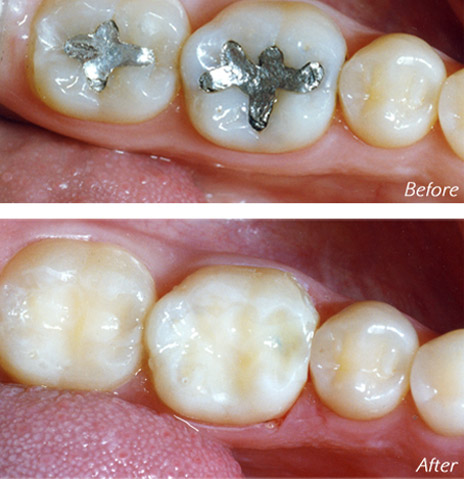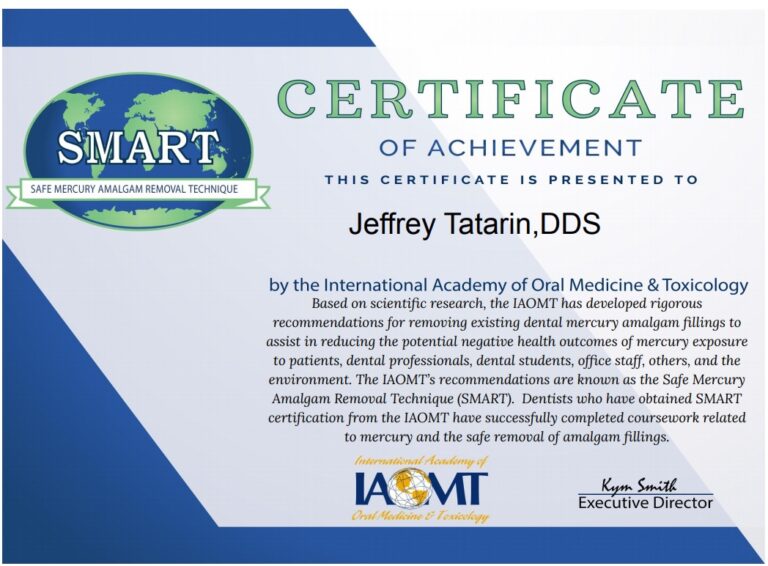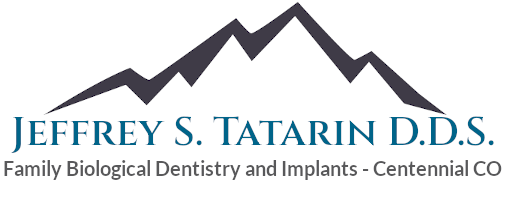Dr. Jeff Tatarin’s Office specializes in the safe removal of mercury amalgam fillings and replacement with modern biocompatible materials. Dr. Jeff Tatarin has achieved certification from the International Academy of Oral Medicine and Toxicology to safely remove mercury dental fillings in a way to reduce the patient’s, staff’s, and environment’s exposure to potentially toxic mercury vapors during their removal and replacement.

Why Replace My Mercury Amalgam Dental Fillings?
Dental amalgam or “silver fillings” contain 45%-55% elemental mercury. Mercury is toxic and this poison is recognized as a chemical of major concern because it poses a dangerous threat to public health. Mercury accumulates in the body, and any amount of mercury taken into the body should be considered hazardous.
Mercury is continuously emitted from dental amalgam fillings, and it is absorbed and retained in the body, particularly in the brain, kidney, liver, lung, and gastrointestinal tract. The output of mercury can be intensified by the number of fillings and other activities, such as chewing, teeth-grinding, and the consumption of hot liquids. Mercury is also known to be released during the placement, replacement, and removal of dental mercury amalgam fillings which is why it is important that it is removed by a certified dentist experienced in its removal.
What Health Dangers Has Mercury Toxicity Been Linked With?’
| Allergies, especially to mercury | Alzheimer’s disease | Amyotrophic lateral sclerosis (Lou Gehrig’s Disease) |
| Antiobiotic resistance | Autism spectrum disorders | Autoimmune disorders/immunodeficiency |
| Cardiovascular problems | Chronic fatigue syndrome | Complaints of unclear causation |
| Hearing loss | Kidney disease | Micromercurialism |
| Multiple Sclerosis | Oral lichenoid reaction and oral lichen planus | Parkinson’s disease |
| Periodontal disease | Psychological issues such as depression and anxiety | Reproductive dysfunction |
| Suicidal ideations | Symptoms of chronic mercury poisoning | Thyroditis |
After the Safe Removal of the Mercury Amalgam Material, What Material is Used To Replace The Old Filling?
This depends on the size of the mercury amalgam filling in the tooth and overall health of the tooth that is being treated. Usually we plan to replace the mercury filling with industry standard tooth-colored composite resin material. This material is extremely strong, cosmetic, and doesn’t contain metal, mercury, fluoride or gluten. Teeth that have excessively large mercury amalgam fillings or have signs of cracking may require crowns after mercury removal to prevent them from breaking down any further. Our dental crowns are gorgeous. They are 100% ceramic and therefore metal, mercury, and gluten, and fluoride free.
What is the Process of Mercury Metal Filling Removal?
After we evaluate the patient to be sure they are healthy enough for routine dental care, we have the patient drink a small amount of activated charcoal as a precautionary measure before the mercury removal. We then place a small nasal canula over their nose and begin to administer pure oxygen that the patient will breathe during the duration of the procedure. This is to be sure they do not inhale any toxic mercury vapors during the procedure. A disposable full-body drape is placed over the patient and a drape is placed over the patient’s face and eyes to protect the patient from any mercury particles. Inside the mouth, the patient will wear a rubber dam to completely isolate the teeth that are being treated. The rubber dam prevents the patient from inhaling mercury vapor and prevents the patient from swallowing any mercury metal particles during the removal. Just prior and during removal a Dent-Air-Vac suction device is positioned near the patients face and begins to suck out mercury vapors and particles. The actual filling is removed by Dr. Jeff Tatarin using a quiet electrical dental drill that is irrigated with distilled water to mitigate aerosolized particles. After Dr. Jeff Tatarin confirms the mercury has been completely removed he will irrigate the tooth with ozone gas and then begin to restore the tooth with new biocompatible material. The process is very straightforward and easy for the patient.
SAFE Mercury Filling Removal Overview:
- Consultation prior to procedure to be sure patient is healthy enough for routing dental care
- Patient drinks small dose of activated carbon an antioxidant
- Nasal canula is placed over the patients nose to administer pure oxygen
- A disposable gown is placed over the patients body and face
- The Dent-Air-Vac suction device is positioned near the patients face to suck out mercury particles and vapor
- A rubber dam is placed in the patient’s mouth to isolate the tooth so patient is not exposed to mercury particles and vapor
- The mercury is removed with a quiet electric dental drill using distilled water irrigation
- Dr. Tatarin confirms 100% of the mercury metal is removed
- Dr. Tatarin irrigates the tooth with ozone gas and then begins to place the new filling material
- Patient is now mercury free with a new much more cosmetic restoration!
What Staff and Environmental Precautions are Taken?
During the procedure our clinical staff wears disposable personal protective equipment including eye protection, non-latex gloves, and a face mask. We also wear a protective gown over our clothing that we take off after the procedure to protect us from mercury particles. The Dent-Air-Vac also protects us by sucking mercury vapors and particles out of the operatory. Our office uses a special mercury amalgam separator to be sure the toxic mercury removed from teeth does not make its way in to sensitive ecosystems.
What Credentials Does Dr. Tatarin Have To Safely Remove Mercury Amalgam Fillings?
Dr. Jeff Tatarin has received accreditation and is certified in the SMART (Safe Mercury Amalgam Removal Technique) mercury removal technique by the International Academy of Oral Medicine and Toxicology.



